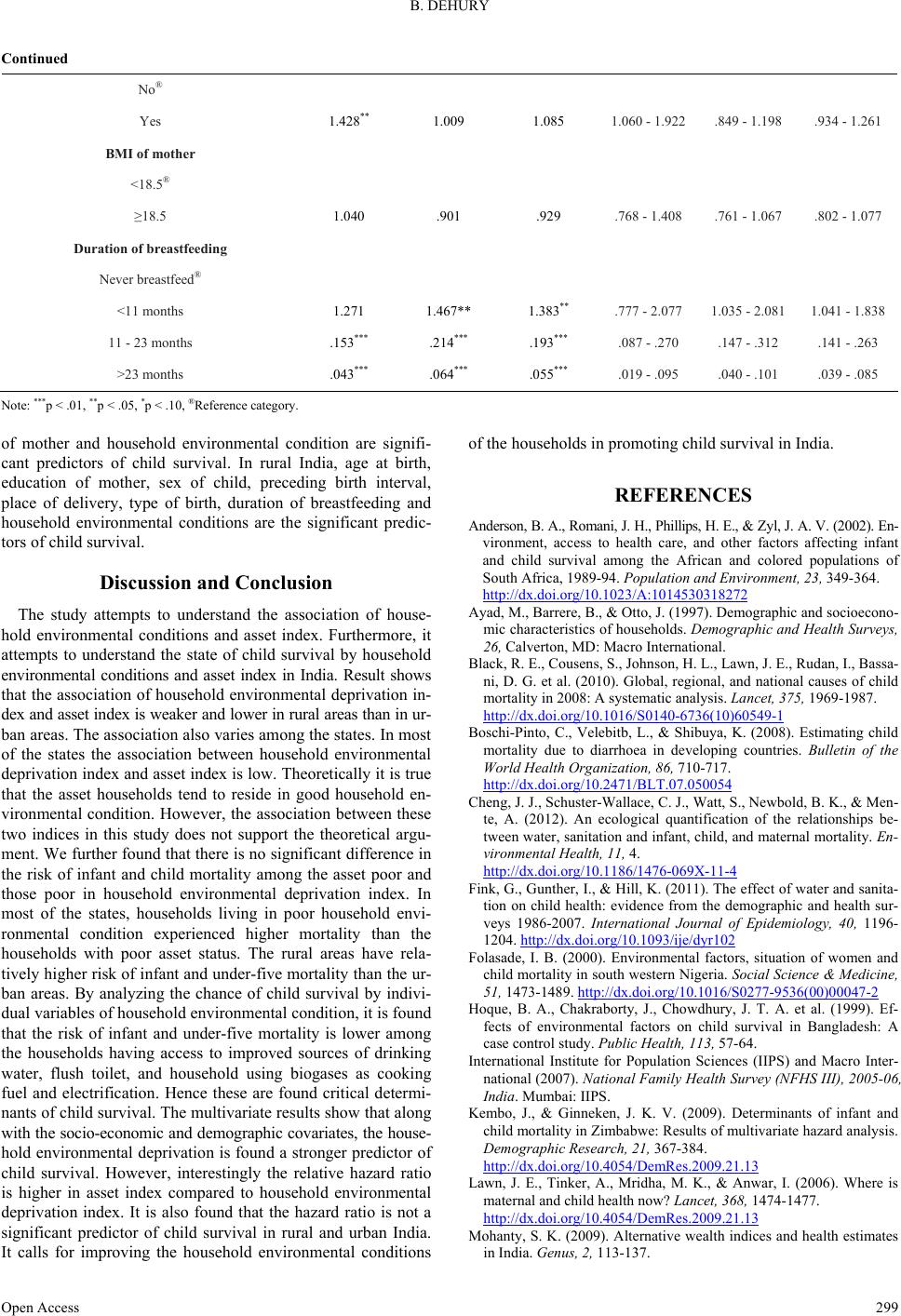
B. DEHURY
Continued
No®
Yes 1.428** 1.009 1.085 1.060 - 1.922 .849 - 1.198 .934 - 1.261
BMI of mother
<18.5®
≥18.5 1.040 .901 .929 .768 - 1.408 .761 - 1.067 .802 - 1.077
Duration of breastfeeding
Never breastfeed®
<11 months 1.271 1.467** 1.383** .777 - 2.077 1.035 - 2.081 1.041 - 1.838
11 - 23 months .153*** .214*** .193*** .087 - .270 .147 - .312 .141 - .263
>23 months .043*** .064*** .055*** .019 - .095 .040 - .101 .039 - .085
Note: ***p < .01, **p < .05, *p < .10, ®Reference category.
of mother and household environmental condition are signifi-
cant predictors of child survival. In rural India, age at birth,
education of mother, sex of child, preceding birth interval,
place of delivery, type of birth, duration of breastfeeding and
household environmental conditions are the significant predic-
tors of child survival.
Discussion and Conclusion
The study attempts to understand the association of house-
hold environmental conditions and asset index. Furthermore, it
attempts to understand the state of child survival by household
environmental conditions and asset index in India. Result shows
that the association of household environmental deprivation in-
dex and asset index is weaker and lower in rural areas than in ur-
ban areas. The association also varies among the states. In most
of the states the association between household environmental
deprivation index and asset index is low. Theoretically it is true
that the asset households tend to reside in good household en-
vironmental condition. However, the association between these
two indices in this study does not support the theoretical argu-
ment. We further found that there is no significant difference in
the risk of infant and child mortality among the asset poor and
those poor in household environmental deprivation index. In
most of the states, households living in poor household envi-
ronmental condition experienced higher mortality than the
households with poor asset status. The rural areas have rela-
tively higher risk of infant and under-five mortality than the ur-
ban areas. By analyzing the chance of child survival by indivi-
dual variables of household environmental condition, it is found
that the risk of infant and under-five mortality is lower among
the households having access to improved sources of drinking
water, flush toilet, and household using biogases as cooking
fuel and electrification. Hence these are found critical determi-
nants of child survival. The multivariate results show that along
with the socio-economic and demographic covariates, the house-
hold environmental deprivation is found a stronger predictor of
child survival. However, interestingly the relative hazard ratio
is higher in asset index compared to household environmental
deprivation index. It is also found that the hazard ratio is not a
significant predictor of child survival in rural and urban India.
It calls for improving the household environmental conditions
of the households in promoting child survival in India.
REFERENCES
Anderson, B. A., Romani, J. H., Phillips, H. E., & Zyl, J. A. V. (2002). En-
vironment, access to health care, and other factors affecting infant
and child survival among the African and colored populations of
South Africa, 1989-94. Population and E nvir on men t, 23, 349-364.
http://dx.doi.org/10.1023/A:1014530318272
Ayad, M., Barrere, B., & Otto, J. (1997). Demographic and socioecono-
mic characteristics of households. Demographic and Health Surveys,
26, Calverton, MD: Macro International.
Black, R. E., Cousens, S., Johnson, H. L., Lawn, J. E., Rudan, I., Bassa-
ni, D. G. et al. (2010). Global, regional, and national causes of child
mortality in 2008: A systematic analysis. Lan ce t , 375, 1969-1987.
http://dx.doi.org/10.1016/S0140-6736(10)60549-1
Boschi-Pinto, C., Velebitb, L., & Shibuya, K. (2008). Estimating child
mortality due to diarrhoea in developing countries. Bulletin of the
World Health Organization, 86, 710-717.
http://dx.doi.org/10.2471/BLT.07.050054
Cheng, J. J., Schuster-Wallace, C. J., Watt, S., Newbold, B. K., & Men-
te, A. (2012). An ecological quantification of the relationships be-
tween water, sanitation and infant, child, and maternal mortality. En-
vironmental Health, 11, 4.
http://dx.doi.org/10.1186/1476-069X-11-4
Fink, G., Gunther, I., & Hill, K. (2011). The effect of water and sanita-
tion on child health: evidence from the demographic and health sur-
veys 1986-2007. International Journal of Epidemiology, 40, 1196-
1204. http://dx.doi.org/10.1093/ije/dyr102
Folasade, I. B. (2000). Environmental factors, situation of women and
child mortality in south western Nigeria. Social Science & Medicine,
51, 1473-1489. http://dx.doi.org/10.1016/S0277-9536(00)00047-2
Hoque, B. A., Chakraborty, J., Chowdhury, J. T. A. et al. (1999). Ef-
fects of environmental factors on child survival in Bangladesh: A
case control study. Public Health, 113, 57-64.
International Institute for Population Sciences (IIPS) and Macro Inter-
national (2007). National Family Health Survey (NFHS III), 2005-06,
India. Mumbai: IIPS.
Kembo, J., & Ginneken, J. K. V. (2009). Determinants of infant and
child mortality in Zimbabwe: Results of multivariate hazard analysis.
Demographic Research, 21, 367-384.
http://dx.doi.org/10.4054/DemRes.2009.21.13
Lawn, J. E., Tinker, A., Mridha, M. K., & Anwar, I. (2006). Where is
maternal and child health now? Lancet, 368, 1474-1477.
http://dx.doi.org/10.4054/DemRes.2009.21.13
Mohanty, S. K. (2009). Alternative wealth indices and health estimates
in India. Genus, 2, 113-137.
Open Access 299